From King Street to Utah; the long trek for religious freedom
Edmund Ellis was born 14 May 1822 in Melksham, Wiltshire, England. He was the son of John Ellis (1786-1858) and Sarah (Nash) Ellis (1792-1876). |
|
 |
Edmund’s family lived on King Street.
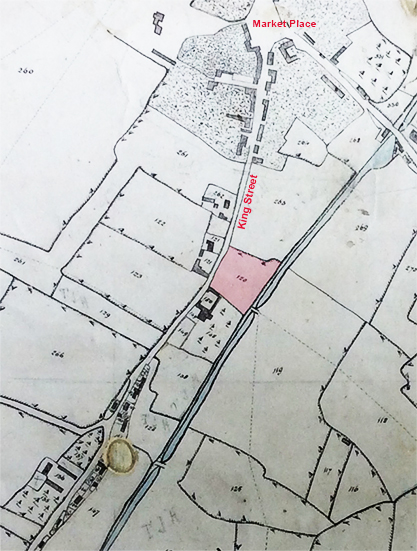 |
|
From the Tithe Map of 1835-6
In the tithe records, John Nash was leasing the premises of a house, shop and garden from the estate of the late Bruges. Indicated in red is the area where this property was located (amongst several others in the same area). Included in this same area is the King Street Tollhouse (which is still standing).
Also living in this area at the time was shoemaker, Stephen Oatley, Edmund Ellis's future father-in-law.
|
Edmund left school at age 9 and he was sent to apprentice as a coppersmith at Seend Iron Works. As he grew older, he learned the butcher business and followed that field for most of his life.
Seend Iron Works in 1889
Iron ore was quarried and smelted in Seend with three blast furnaces fifty feet high, and employed 300 men. The quarry closed in 1946.
|
|
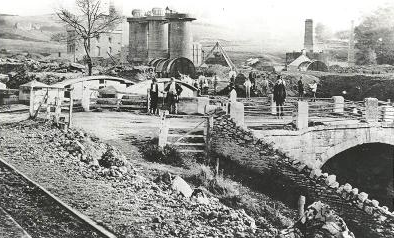 |
Edmund’s parents were good religious people and he was raised in the Independent Church.
Edmund married Martha Oatley (1820-1853) in Melksham on 11 November, 1841. Martha’s parents were Stephen Oatley, a shoemaker on King Street (1792-1957) and Rachel Jarvis (1793-[before 1832])
In June 1841, at the age of 19, Martha was working as a dressmaker and living with Ann (Tuck) Oatley in Shurnhold.
After Edmund and Martha married, they lived in The City, near where Martha grew up, and he worked as a dealer in meat.
They had four children:
● John Ellis (1842-1912)
● Elizabeth Ellis (1844-1930)
● Frederick William Ellis (1846-1933)
● Edward Ellis (1848-1932)
One day, Mormon Missionaries called at the Ellis home, left tracts, and invited the family to a meeting the following Sunday. Martha was happy and relayed the message of a new church in America when her husband came home. He was interested but offered to stay home and cook the dinner while his wife attended church.

As he was cooking the meal over the fireplace, he heard music and a prayer. At first he said he thought it was coming from heaven then he realised the sound was coming down the chimney. He got his bible and followed along with the sermon. When his wife came home she started to tell him what had been said. He laughed and finished her sentences for her.
He always joked about hearing the gospel down the chimney.
Sadly, at the age of 33 as Martha was giving birth to twins in 1853, she and the two babies died. Edward was left alone with four children under the age of 10.
Edward’s work, selling his meat from a cart on a route that covered 12 miles, meant he was often away overnight.
Some of the widows in the neighbourhood offered to help by coming into the home, but he found they were disposing of his fine linens, bedding and the children’s better clothing, leaving them almost destitute.
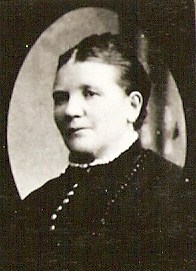 |
|
Some months after his wife died, he renewed a friendship with a woman named Sarah he had met during his apprenticeship.
She had attended school until the age of 9 and was then apprenticed to a corset maker for seven years. She also worked as a finisher for gentlemen's clothing.
Sarah Grace Barnaby was born 10 April, 1832 in Trowbridge, Wiltshire. Her parents were William Barnaby (-1840) and Mary (Davis) Barnaby (1794-1859).
Sarah Grace accepted Edmund's proposal, but their wedding had to wait a few months.
At the time, Sarah Grace was engaged by Queen Victoria as a maid-in-waiting and her duty was to the full charge of the Queen’s children.
|
The Queen was kind and understanding but said that if Sarah Grace would stay just a few months longer, she would help her with her trousseau, so Sarah and Edmund agreed to wait.
The Queen kept her promise and many of the lovely things she gave Sarah Grace, such as a black silk shawl with long fringe, remain in the Ellis family today. |
|
 |
When Sarah Grace married Edmund on 16 January, 1854 at the Tabernacle Chapel in Trowbridge and came to the home, she could see how much this family needed a mother, so she set about to do her part. A short time after her marriage she was converted to the Church of Latter Day Saints and was baptised on 14 February, 1854 by Elder James Berry.
Sarah Grace and Edmund had five children, but Martha Jane died in infancy.
They were:
● Mary Ann Ellis (1855-1926)
● Julia Amanda Ellis (1857-1880)
● William Moroni Ellis (1860-1943)
● Martha Jane Ellis (1862-1862)
● Sarah Lillian Ellis (1870-1932)
The Ellis family always kept a home for the missionaries when they came through Melksham. In fact, the 1861 census reports Mr. C. H. Michaels, a Mormon missionary from Utah, a territory of the United States at the time, was staying with them.

But when it was discovered they had joined the Mormon Church, they became extremely unpopular.
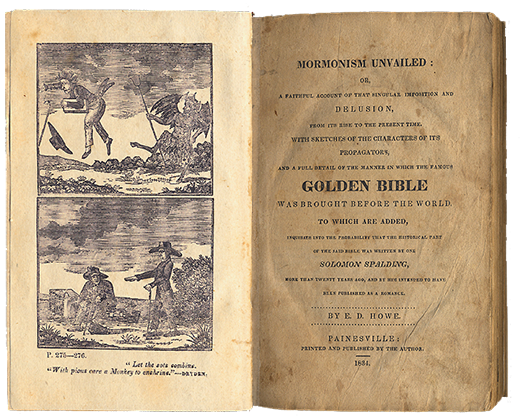
There were very few members of the Church living in Melksham and they endured many trials. Mobs would follow them to Church, making remarks, throwing rotten eggs, apples and other trash at them.
Many times rocks were thrown through the windows of Mormons’ homes at night, barely missing them as they slept.
There was a growing outcry of anti-Mormonism with several books and pamphlets written; one suggested that founder Joseph Smith was a “blockhead,” a “juggling, money-digging, fortune-telling imposter”.
Naturally they became anxious to go to the gathering place of their religion. They saved and worked, and when the opportunity came, the two oldest children, John and Elizabeth were sent with converts in 1859. Then son Fredrick was also sent to help prepare the way in 1866. Their son Edward remained to help with the three younger children.
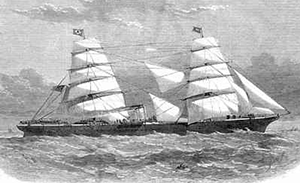 |
|
The Perpetual Emigration Fund made available by members of the Church, helped the family to set sail in 1867, which was a long tedious trip of three weeks.
Sarah Grace did not enjoy the voyage on the SS Manhattan (illustrated, left) as she was seasick all the way. |
From 1847 to 1869, more than 32,000 British and Irish converts to the Church left their homelands for a new life in pioneer America.
When they landed they went to the home of Edmund’s uncle James Axford in Philadelphia Pennsylvania, who had offered him and his son Edward work in his department store. But James refused to hire them unless they gave up their ridiculous religion, which they would not do.
Edmund tried to find work at his old trade as coppersmith but his tools were old fashioned and he was not accepted. They left Philadelphia after one year.
He then moved his family to Germantown, Pennsylvania, where Edward found work as coachman and hostler to a gentleman there.
Edmund worked at breaking rock for road construction until spring. His son Fredrick had sent him $50.00 to help the family on their way to Utah. He left Edward in Pennsylvania to earn enough money to follow at a later date.
Edmund, his wife and children took a train to Benton, Wyoming and joined a company headed by Capt. Simpson Molen (right) to enable them to cross the 1,000 miles of desert.
They made up a group of 300 people and 61 ox teams.
Edmund and his daughters Mary Ann and Julia walked every step of the way except when fording streams. |
|
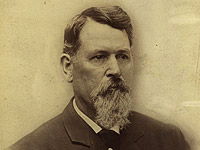 |
They arrived in Salt Lake City, Utah on 3 September, 1868.

|
|
In 1869 the family, except John and Elizabeth, moved to Weber County, Utah, located on a bluff of land known as Pole Patch, at the foot of Ben Lomond Mountain, and remained there about one year. Ben Lomond Mountain in Utah might look familiar to you.
Hover your mouse over this image to reveal a well known logo. |
He then purchased nine acres of land in Pleasant View, Utah where he constructed a home by making an excavation in the side of the hill. They lived in this dug-out and rented some farm land. It was in this crude home that their daughter Sarah Lillian was born.

He was assisted by his son Edward, and the crops were planted, came up, but the bounteous harvest was never realised because of the grasshopper plague.
The family gathered some grain which was left among the sunflowers here and there, after the grasshoppers left. This was threshed by hand and amounted to twelve bushels and lasted the family for bread until the next harvest.
| Edmund also did considerable carpentry work, making amongst other things, washtubs, vats for butter, kegs and firkins, such as the object shown at right. |
|
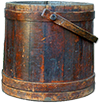 |
Both Sarah Grace and Edmund became afflicted with crippling rheumatism in their later years, and they moved to North Ogden, Utah.
Edmund’s son, William, built two rooms onto the home of their daughter Lillian Ellis Ferrin, and she took care of her parents with the help of her sister, Mary Ann Ellis Cragun, until their death.
To learn more about the Mormon journeys across the prairies, read their fascinating
diaries.











